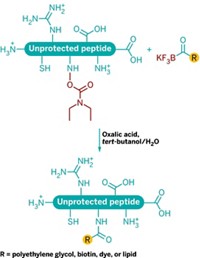Advertisement
Grab your lab coat. Let's get started
Welcome!
Welcome!
Create an account below to get 6 C&EN articles per month, receive newsletters and more - all free.
It seems this is your first time logging in online. Please enter the following information to continue.
As an ACS member you automatically get access to this site. All we need is few more details to create your reading experience.
Not you? Sign in with a different account.
Not you? Sign in with a different account.
ERROR 1
ERROR 1
ERROR 2
ERROR 2
ERROR 2
ERROR 2
ERROR 2
Password and Confirm password must match.
If you have an ACS member number, please enter it here so we can link this account to your membership. (optional)
ERROR 2
ACS values your privacy. By submitting your information, you are gaining access to C&EN and subscribing to our weekly newsletter. We use the information you provide to make your reading experience better, and we will never sell your data to third party members.
Synthesis
Supported Cross-Metathesis
Linker promotes effective alkene coupling
by Carmen Drahl
November 26, 2007
| A version of this story appeared in
Volume 85, Issue 48

OLEFIN CROSS-METATHESIS, the coupling of two distinct alkenes, is a useful synthetic organic reaction, but it has only rarely been achieved on solid phase. Researchers have now found that proper spacing between the polymer support and the tethered alkene makes the solid-phase reaction more feasible.
Solid-phase synthesis is used to construct diverse small-molecule libraries in an automated fashion, allowing easy removal of by-products and excess reagents from reaction mixtures. The finding could aid the use of olefin cross-metathesis in discovering compounds with novel bioactivities.
Kazunori Koide, assistant professor of chemistry at the University of Pittsburgh, and graduate student Amanda L. Garner found that increasing the distance between the polymer and the support-bound olefin in olefin cross-metathesis reactions leads to higher product yields (Org. Lett., DOI: 10.1021/ol702415x).
To apply their findings to diverse substrates, Koide and Garner constructed a novel solid support by attaching a linker to a well-known polystyrene resin. Cross-metathesis of several alkene substrates proceeded in moderate to good yields on the team's new polymer support but poorly on supports lacking a linker.
But earlier studies of solid-phase metathesis by other groups show that increased linker length is beneficial only up to a point, Koide cautions. "If the linker is too long, two olefins bound to the solid support may reach each other and react" and form an undesired product, he says.
Sequestering one of the reacting olefins on a solid support is one way to boost yields of desired coupling products while minimizing metathesis of one partner with itself, according to Helen E. Blackwell, assistant professor of chemistry at the University of Wisconsin, Madison. A rigorous study of solid-phase olefin cross-metathesis "has been warranted for many years," she adds.
The new method is "mild and should be straightforward to implement on various substrates," Blackwell says. As an example, Garner and Koide implemented their new technology to perform a cross-metathesis reaction between a natural product substrate and a solid-supported epoxide. Koide next plans to build a library of highly functionalized compounds for biological studies.





Join the conversation
Contact the reporter
Submit a Letter to the Editor for publication
Engage with us on Twitter